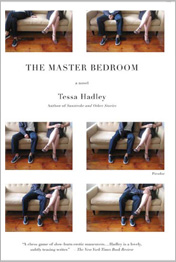By Connie Nardini
“It’s not a sign. Kate refused to let it be a sign.”
Kate Flynn, the opening character in Tessa Hadley’s 2008 novel The Master Bedroom, was involved in a auto accident at the end of a long and frustrating drive. And it seemed to contain a sign – “In the dim light something fell from the sky; at first Kate thought it was a bundle of dirty washing wrapped in a sheet.” But it turned out to be a swan that bounced off a truck and hit a car in front of Kate. After the ensuing pile-up, no one was really found to be hurt but everyone involved was confused and upset. The Swan from the Sky drew a long trail of consequences behind it that seem very believable and ordinary, but who can tell a real omen from a fake one? Should omens come “wrapped in a dirty sheet?”
 The story of The Master Bedroom is both ordinary and eerie. It takes place in Cardiff, Wales, and tells of characters from Kate, a narcissistic, thinly beautiful and childish professor of esoteric literature, to a teenage boy, Jamie, who is broodingly intelligent and also quite beautiful, who courts and wins her. Throw in Jamie’s father, David, whom Kate really lusts after (in a ladylike way) and you have a story. As far as the significance of the bedroom, you’ll need to find out for yourself.
The story of The Master Bedroom is both ordinary and eerie. It takes place in Cardiff, Wales, and tells of characters from Kate, a narcissistic, thinly beautiful and childish professor of esoteric literature, to a teenage boy, Jamie, who is broodingly intelligent and also quite beautiful, who courts and wins her. Throw in Jamie’s father, David, whom Kate really lusts after (in a ladylike way) and you have a story. As far as the significance of the bedroom, you’ll need to find out for yourself.
Hadley wraps the tantalizing dance of miscommunications, betrayals, revelations and her style of metaphor in enough fog of mystery to keep the reader (at least this reader) chained to the baroque pattern of the telling. Her description of Kate’s house – a mansion that was named Firenze by her grandfather, who was overcompensating for his mercantile background – echo Kate’s situation. Its glamor was fading but still mesmerizes those who would live in or even visit it – its mirrors “glinted like dark pools.” Also remember, this is the house of one of the master bedrooms.
The other one is part of David’s house, which he shares with his wife and two children. Now we really have a story!
And speaking of “the story”: There is a department at the Massachusetts Institute of Technology called the Center for Future Storytelling, according to a Nov. 11 story in The New York Times. Its purpose, as I understand it, is to ponder the viability of the story as we have known it. Is a story with a beginning, a middle, and an end in trouble in our modern world of text-messaging? There is even a man, David Kirkpatrick of Plymouth Rock Studios, who is thinking of putting together a documentary called The World Without a Story.
All I can say is if Tessa Hadley was without a story we would be in a boring world indeed. A good story will always beat with life.
–
Previously in Connie’s Corner:
* “Heavier Than Air.” Nona Caspers creates a tapestry of small towns and chronicles the lives of people living there who have a hard time coming down to earth.
* “Pale Fire.” Nabokov creates a novel that doesn’t seem to have coherent plot but a story that contains a do-it-yourself kit.
* “Out Stealing Horses.” A coming-of-age story that reveals a father’s secret life during wartime.
* “An American In Iceland.” Answering the riddle: how many Icelanders does it take to change a light bulb?
* “The Physics of the Dalai Lama.” How Buddhism squares with quantum mechanics.
* “Finn.” Some kind of monster.
Posted on December 15, 2008


